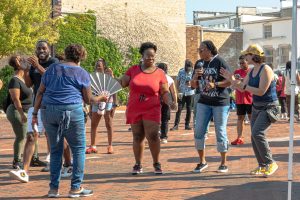Reporter access policy controversy avoids NIU
October 30, 1990
In the wake of a recent rash of incidents involving female reporters in sports locker rooms, increased attention has been devoted to the debate regarding equal access.
The most recent incident involved female reporters denied access to the football locker room at Syracuse University.
This is an issue that NIU sports has managed to avoid thanks to the NCAA which does not govern access of college locker rooms to reporters. This has allowed NIU to implement its own basic policies concerning reporters.
NIU’s basic policy is that no reporters are allowed in the locker room area. This goes for football, volleyball, men’s and women’s basketball and soccer.
NIU head football coach Jerry Pettibone and his team conduct their interviews in a press room after a game. “We’ve used this policy because it’s best for us and we’ve had no problems and no complaints,” said Pettibone.
Of the 106 Division I-A football programs, 71 of them, including NIU, bring players and coaches to a post-game press conference. 21 allow all reporters to enter the locker room. 14 prohibit female reporters in football locker rooms while giving male reporters full access.
As for the NIU men’s and women’s basketball teams, both will often have specific players brought out that the media has requested. They then go to a press room to conduct their interviews.
Women’s basketball coach Jane Albright feels that it is necessary for a player to talk to the media, but not in a locker room. “It’s a player’s responsibility, whether they are in the NFL or in college, to talk to the press,” Albright said.
“But not in a locker room. Locker rooms should be treated like one’s home. It’s a private place and wrong for a male or a female to be in there.
“I don’t think a press room takes anything away from an interview. It doesn’t have to be anything formal either, but just a room to talk to the players after they’ve cooled off.”
Men’s basketball coach Jim Molinari agreed with Albright. Molinari said that at the college level, players should be given the opportunity to cool off after a game. “I could see if reporters wanted to talk to professional players right after a game, but these are still young kids and they should be given some time to cool off,” Molinari said.
He also feels that in basketball, with a limited number of players on the team, the coach can be much more in control. “It’s not like football where you have a lot more players,” said Molinari. “A basketball coach has much more control and if we ever did have a woman reporter in our locker room, we’d make sure the uniforms stayed on.”
Sometimes the situation arises in which the players stay on the playing field or floor where the interview is conducted. This sometimes happens in basketball, and always happens for the volleyball and soccer teams.
“Our players wait on the court after the game on purpose,” said women’s volleyball coach Pete Waite. “The reporters talk to the players on the court and if they can’t reach them there, then they wait until after they’ve left the locker room.”
Soccer coach Willy Roy also has the same approach to reporters as Waite, and wonders why this issue is receiving so much attention.
“I don’t know why everyone’s making such a big deal out of this,” said Roy. “We have an open policy and realize that reporters are just doing their jobs. At NIU we are doing the right thing.”
Roy personally feels that it doesn’t matter where a reporter holds their interview, whether it’s on the field, in a press room, or a locker room, as long as the players have uninterupted time in the locker rooms. “As long as the kids get time to shower, I don’t care where they interview them,” said Roy.
So far, NIU has avoided controversy in an area that has been very sensitive in recent weeks.






